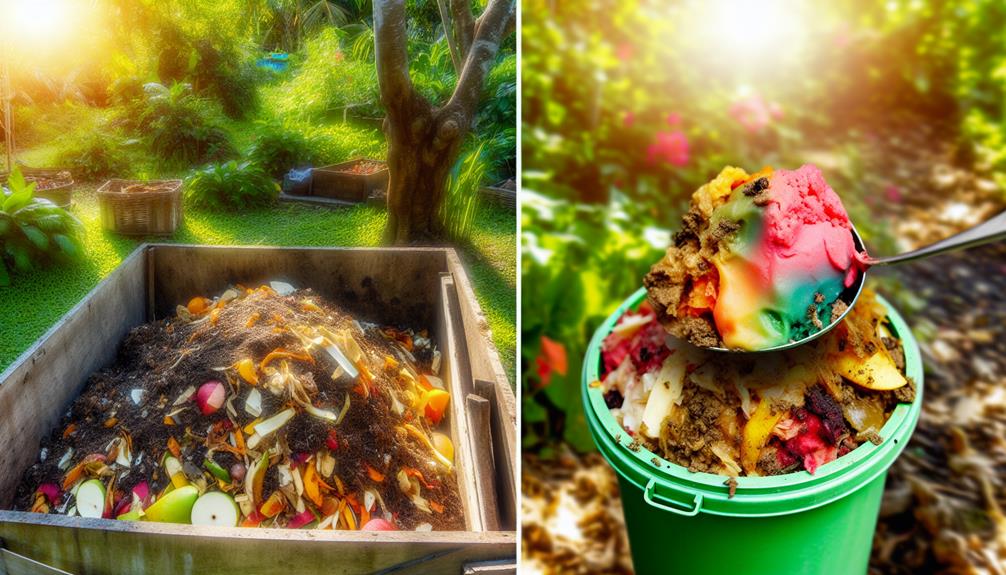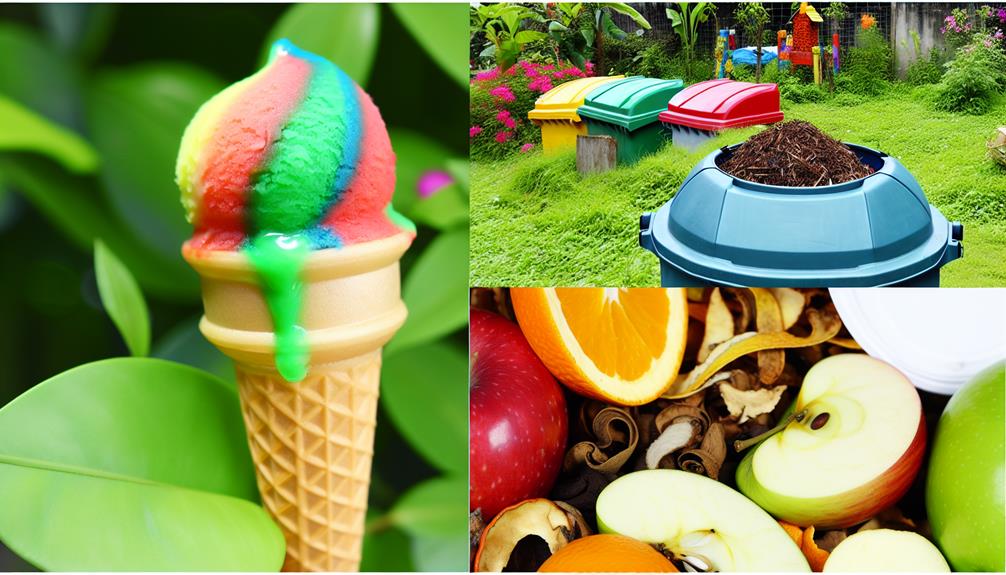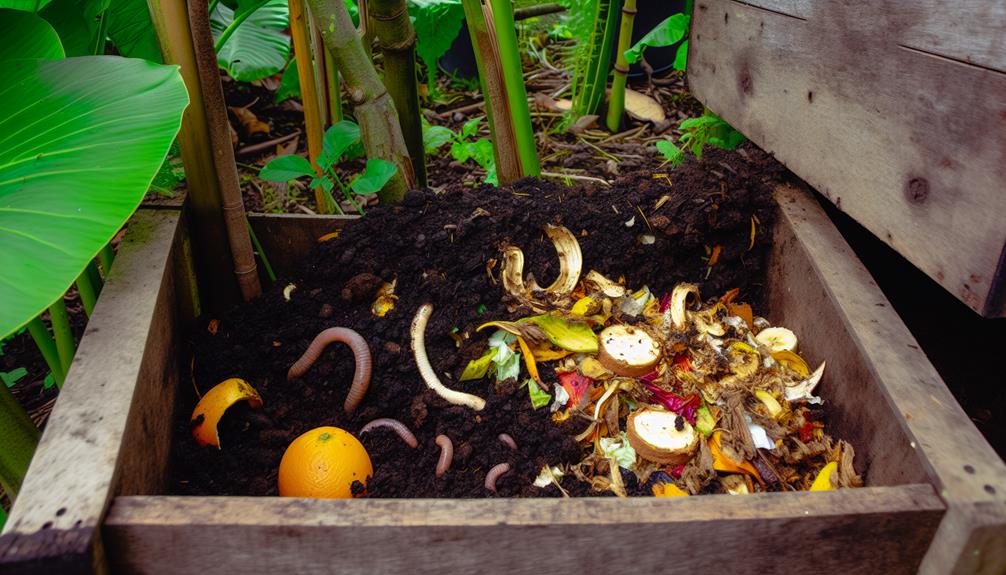

Yes, you can compost ice cream, but you need to do it carefully. Due to its dairy and fat content, ice cream can attract pests and create odors. To compost it successfully, balance it with carbon-rich materials like leaves or shredded paper.
Make sure to aerate the compost pile to help break down the fats and dairy. Avoid ice creams with artificial sweeteners and high amounts of preservatives, as these can be harder to decompose. Always cover your compost to manage pests and odors. To learn more about optimizing your compost process and managing potential issues, keep exploring.
Composting’s fundamental principle is turning organic waste into nutrient-rich soil through natural decomposition processes. To grasp composting basics, you need to understand how microbial activity and compost structure play essential roles.
Microbes like bacteria, fungi, and actinomycetes are the real workhorses in your compost pile. They break down organic matter into simpler compounds, transforming waste into valuable soil amendments.
To foster effective microbial activity, you should focus on maintaining a balanced compost structure. This means ensuring your compost includes a mix of green materials (like fruit and vegetable scraps) and brown materials (such as dry leaves and cardboard). The greens provide nitrogen, while the browns supply carbon. Microbes need both to thrive and work efficiently.
You’ll also want to keep your compost pile moist but not soggy, as water is critical for microbial survival. Regularly turning the pile introduces oxygen, which aerobic microbes require. A well-aerated compost pile speeds up decomposition and reduces unpleasant odors.
Also Read: Can You Compost Celery?
When composting ice cream, you need to understand its composition. This includes dairy and fat content, sugar and sweeteners, and various additives and preservatives. These components affect how ice cream breaks down and integrates into compost. Knowing what’s in your ice cream helps you manage the composting process more effectively.
To comprehend how to compost ice cream effectively, you first need to know its dairy and fat content. Ice cream is primarily made from milk and cream, contributing to its rich and creamy texture. The dairy content introduces proteins and fats, which are essential for both the flavor profiles and serving suggestions. These components can be challenging to compost because they break down slower than plant-based materials.
When you add ice cream to your compost, you must consider its fat content. High-fat content can attract pests and create odors if not managed correctly. To mitigate this, balance the ice cream with carbon-rich materials like dry leaves or cardboard. This helps absorb excess moisture and speeds up decomposition.
Fats also need oxygen to break down efficiently. Ensure your compost pile is well-aerated by turning it regularly. This not only helps in breaking down the dairy and fats but also maintains a healthy microbial environment.
Let’s explore the role sugar and sweeteners play in the composition of ice cream and how they affect the composting process. Ice cream typically contains natural sugars like sucrose, which not only sweeten the dessert but also affect its texture and freezing point. These natural sugars are organic and break down relatively quickly in a compost pile.
However, many ice creams include sugar alternatives, such as artificial sweeteners or sugar alcohols. These alternatives can complicate composting because they don’t decompose as easily as natural sugars. It’s essential to understand how different sweeteners behave in compost.
Here’s a quick breakdown:
When composting ice cream, aim for those made with natural sugars or natural alternatives. Avoid products high in artificial sweeteners to maintain a healthy compost environment. This knowledge helps you contribute to a more sustainable and efficient composting process.
While understanding the role of sweeteners is vital, examining the additives and preservatives in ice cream is equally important for effective composting. Ice cream often contains chemical additives like stabilizers, emulsifiers, and artificial flavors. These ingredients can complicate the composting process because they don’t break down as easily as natural ingredients.
When you’re composting ice cream, it’s important to be mindful of these chemical additives. Stabilizers like guar gum and carrageenan, for instance, are designed to maintain texture and can persist in your compost pile. Emulsifiers such as lecithin or mono- and diglycerides also resist decomposition. Artificial flavors and colors are another concern, as they may introduce synthetic compounds into your compost, potentially affecting the health of your soil.
Packaging waste is another aspect to consider. Ice cream often comes in containers lined with plastic or other non-compostable materials. Always separate the ice cream from its packaging before adding it to your compost bin. Opt for products with more eco-friendly packaging when possible.
Also Read: Can You Compost Basil?
Composting ice cream can greatly reduce waste and lower the carbon footprint associated with food disposal. When you compost your leftover ice cream, you’re helping divert food waste from landfills. This action alone can substantially contribute to landfill reduction, which is vital for minimizing methane emissions and conserving space for future generations.

By composting ice cream, you’re also turning what would be waste into a resource that enriches soil. Here are some benefits:
You’re not only playing a role in waste reduction but also fostering a community spirit focused on sustainability. Together, we can make a significant environmental impact.
Start composting your ice cream today and join a growing number of eco-conscious individuals working towards a greener planet.
When composting ice cream, you should take into account how quickly dairy products decompose and the potential for attracting pests. Dairy can break down at a different rate compared to plant-based materials, which might impact your compost’s balance.
Additionally, the sweet smell of ice cream can draw unwanted pests, so managing these factors is essential.
Understanding the decomposition rate of dairy products like ice cream is essential because they can attract pests and produce unpleasant odors if not managed properly. When composting ice cream, you need to pay special attention to temperature control and moisture levels. These factors play a significant role in how quickly the ice cream will break down and how effectively it integrates into your compost pile.
Here are some key points to keep in mind:
Managing the decomposition rate effectively also helps mitigate concerns about attracting pests to your compost pile. Ice cream, like other dairy products, can be a magnet for pests if not composted properly. To minimize pests attraction, you should balance the nitrogen-rich ice cream with plenty of carbon-rich materials, such as leaves or cardboard. This balance speeds up decomposition and reduces odors that attract pests.
Properly covering your compost pile is another essential pest deterrent. Use a thick layer of brown materials like straw or sawdust on top of the compost. This helps mask the smell and makes it less likely for pests to detect and invade your pile.
Turning your compost regularly is also critical. Frequent turning aerates the pile, promoting faster decomposition and reducing odors that attract pests. Aim to turn the pile at least once a week.
Additionally, consider using pest deterrents like wire mesh or compost bins with secure lids to keep larger pests such as raccoons and rodents out.
Instead of composting, you can explore other eco-friendly methods to dispose of ice cream waste. By considering various disposal methods and recycling options, you’ll contribute to a more sustainable environment and avoid the pitfalls of composting dairy products.

Here are some alternatives:
While alternatives to composting ice cream are worthwhile, knowing how to compost it correctly can still be beneficial for your garden.
When composting ice cream, start by considering the flavor variations. Chocolate and vanilla can both go into your compost, but avoid those with large chunks or artificial additives. These ingredients may take longer to break down or could introduce unwanted chemicals into your compost.
First, make sure the ice cream is melted before adding it to your compost bin. This helps it integrate more easily with other compost materials. Mix the melted ice cream with a good balance of browns (like dried leaves) and greens (like vegetable scraps) to maintain proper compost conditions.
Next, be mindful of quantities. A small amount of ice cream can be beneficial, but too much dairy can upset the balance of your compost pile, leading to odor issues and slow decomposition.
Reducing food waste not only benefits the environment but also saves you money and resources. To maximize food waste reduction, start by understanding the waste hierarchy: prevention, reuse, and recycling.

Here are practical steps you can take:
Yes, composting ice cream can attract pests. Use pest deterrents and covering methods like adding dry leaves or soil to help. You’ll keep your compost bin community-friendly and pest-free by following these simple steps.
You’re wondering how long the decomposition process for ice cream takes in compost. Typically, it decomposes within a few weeks, but the environmental impact is minimal compared to other food waste. Together, let’s compost responsibly!
You should compost melted ice cream rather than frozen. Temperature considerations affect nutrient breakdown, and warm, melted ice cream integrates more smoothly into your compost, breaking down nutrients faster and helping your composting community thrive.
Yes, you can compost dairy-free ice cream just like regular ice cream. Both types have nutrient content beneficial for compost. Vegan considerations don’t change the process, so you’ll still contribute to a thriving community garden.
You should avoid composting ice cream with artificial additives or preservatives. These substances can harm your compost’s natural balance. Embrace a community-minded approach by keeping your compost organic and free from preservative concerns.
You can compost ice cream, but it requires careful consideration. Guarantee the ice cream is free of non-compostable additives and packaging.
Mix it with carbon-rich materials like leaves or cardboard to balance its high nitrogen content. Monitor for pests and odors, as dairy can attract unwanted visitors.
If composting isn’t feasible, consider donating unopened ice cream to food banks or using it in creative recipes to minimize waste.
Always aim to reduce food waste responsibly.

Don't let aphids, slugs, and caterpillars ruin another plant. Take back control with simple, natural methods that actually work.